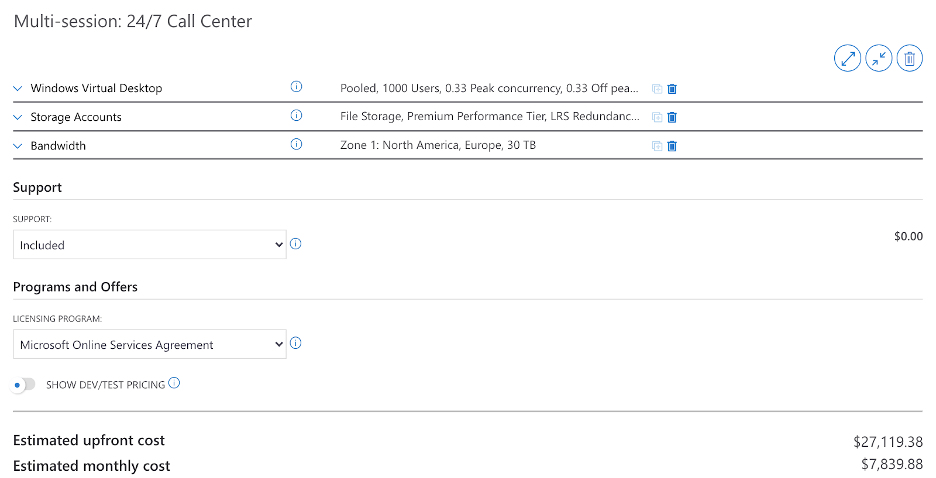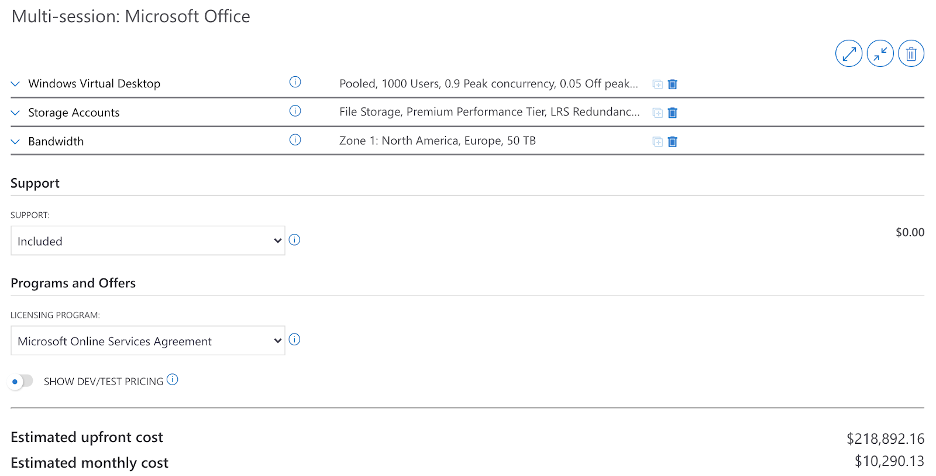More about VDI on Azure
- FSLogix: An In-Depth Look
- Azure Remote Desktop Services and WVD: Which is Right for You?
- NetApp Virtual Desktop Managed Services: DaaS at Enterprise Scale
- Azure Windows Virtual Desktop: How to Setup, Deploy, and Manage a Cloud-Based VDI
- Azure VDI Pricing Deep Dive: How to Calculate Windows Virtual Desktop Costs
- The UX Dream Team: Windows Virtual Desktop, FSLogix, Azure NetApp Files
- Amp Up End-User Experience in Windows Virtual Desktop With Azure NetApp Files
Subscribe to our blog
Thanks for subscribing to the blog.
September 13, 2020
Topics: Azure NetApp Files AzureElementary6 minute read
Windows Virtual Desktop (WVD) enables you to manage virtual desktop infrastructure (VDI) on the Azure cloud. Azure VDI pricing is impacted by three main factors—infrastructure, WVD Management Service, and licensing.
When deploying VDI on Azure, you can choose between licensing for Windows 7 and Windows 10 machines or licensing for Windows Server. You can also choose between personal desktops, pooled desktops, and applications only. Each option offers different billing plans for a wide range of applications and users.
In this post, we’ll explain the main factors influencing Azure VDI pricing and examine two examples. We will also show how Azure NetApp Files can provide virtual desktop environments with high availability and unprecedented cloud performance.
In this article, you will learn:
- Licensing Options for Windows Virtual Desktop
- Calculating Windows Virtual Desktop costs
- Azure VDI pricing examples
- Azure VDI Pricing with Azure NetApp Files
How Does Licensing Work for Windows Virtual Desktop on Azure?
To use Azure Windows Virtual Desktop (WVD) you need to have an eligible license or subscription per user you want to connect. Eligible licenses grant you access to both Windows 7 and Windows 10 machines.
The licenses that can grant you this access include:
- Windows 10 Enterprise E5 or E3
- Windows 10 Education A5 or A3
- Windows 10 Virtual Desktop Access (VDA)
- Microsoft 365 F3 or E3 or E5
- Microsoft 365 A3 or A5 or Student Use Benefits
- Microsoft 365 Business Premium (formerly called Microsoft 365 Business)
Depending on the license you have, you can also use any eligible products the license covers on your virtual desktops. Any Microsoft 365 licenses grant access to the entire Office365 suite. However, Windows licenses do not require additional licensing.
You can add these rights with a subscription to Office365, Office Professional Plus, or Office Standard with network use. You should also keep in mind that Windows Enterprise Upgrade licenses obtained through the Volume License program are not valid.
Windows Server
Another option is to access WVD based on Windows Server rather than Windows 7 or 10. If this is the OS you want to use, you need a license for Windows Server. For this license you can either:
- Purchase the license as part of your Azure subscription. This is pay-as-you-go and more expensive.
- Purchase Azure Hybrid Benefits for Windows Server Core. This includes Software Assurance and is a cheaper option.
When using Windows Server, you also need to license Remote Desktop Services. You can obtain this licensing through:
- Windows Server RDS User client access licenses (CALs), that are covered with Software Assurance
- The Cloud Solution Provider (CSP) program
- Devices with existing RDS Device CALs
If you want to use Office365, licensing is the same as for using Windows 7 or 10 desktops.
Calculating Windows Virtual Desktop Pricing
When calculating the cost of operating Microsoft Windows Virtual Desktop, there are three main components to consider—the infrastructure, the WVD Management Service, and the licensing (as covered above).
Azure infrastructure to run desktops and apps
When implementing WVD there are two types of desktops you can choose from. There is also the option to deliver only specific applications or application sets.
- Personal desktop—desktops are directly assigned to a single user. This is typically used when you need persistent desktops that users can customize.
- Pooled desktop— users are assigned desktops from an available pool of machines. This is typically used when users only need a generic desktop that they are not customizing.
- Applications only—select applications are delivered without full desktop accessibility. This is typically used when users only need limited access, such as with kiosks.
In all three implementations, WVD delivers a virtual machine with the required functionality. Every virtual machine delivered is hosted within your Azure subscription and uses compute, storage, and networking resources tied to your account.
The actual amount you are charged is based on your individual consumption costs. These include:
- Which series of virtual machines you are using
- Whether you are using Reserved Instances or On-Demand
- The type of storage used by each machine (i.e. Standard HDD, Standard SSD, or Premium SSD)
- The OS disk capacity of each machine (i.e. 128GB, 256GB, or 1TB)
- The average number of users per virtual CPU (vCPU)
- The average GB of RAM per user
- How much data is transferred from Azure per month
- Any additional services you are using (i.e. backup, virtual private networks (VPNs), replication, etc.)
The easiest way to find your exact costs is to use pricing tools like the Azure Calculator. With this tool, you can modify your implementation to fit a wide variety of scenarios to uncover which configurations are best for your needs and budget.
WVD Management Service
WVD Management Service is a platform offered by Azure that serves as a control plane for WVD. It provides the same functionality as RDS roles, used to manage the lifecycle of desktops and determine how users connect to desktops, in a single platform. You can manage this service through PowerShell, REST API, or the Azure admin portal.
This service makes management significantly easier than similar implementations with RDS. In the latter cases, IT teams were required to build domain-joined machines with individual control roles installed. This required more machines and infrastructure resources. WVD Management Service enables you to leave these responsibilities to Azure. The cost of this service is included with your license or subscription.
Examples of Azure VDI Costs
While you can use the previously mentioned calculator to assess your own potential VDI costs, it may help to understand Windows Virtual Desktop pricing for two common scenarios.
24/7 call center
This example is for a call center, such as that used for support and service delivery in an enterprise-scale environment. This scenario is designed to support 1,000 staff at a time. Staff work in three, eight-hour shifts and require low compute intensity resources.
To meet these requirements, 24/7 Reserved Instances are used. Each is connected to a distributed bandwidth pool of 30TB. You can see how pricing is calculated for this scenario below.

Knowledge workers
This example is for knowledge workers, for example, content creators or marketers. This scenario is designed to support 1,000 staff using primarily Office suite products and requiring high-intensity resources.
For this scenario, Azure recommends using 24/7 Reserved Instances so you do not have to devote resources to managing your virtual machines. Each instance is connected to a distributed bandwidth pool of 50TB. You can see how pricing is calculated for this scenario below.

Azure VDI Pricing with Azure NetApp Files
Azure NetApp Files is a Microsoft Azure file storage service built on NetApp technology, giving you the file capabilities in Azure even your core business applications require.
Get enterprise-grade data management and storage to Azure so you can manage your workloads and applications with ease, and move all of your file-based applications to the cloud.
Azure NetApp Files solves availability and performance challenges for enterprises that want to move mission-critical applications to the cloud, including workloads like HPC, SAP, Linux, Oracle and SQL Server workloads, Windows Virtual Desktop, and more.
In particular, Azure NetApp Files helps virtual desktop environments benefit from a comprehensive file share service that’s highly available and offers unprecedented cloud performance. This allows you to solve user experience challenges, with fast access to storage, and assure administrators that their environments will not go down with an unexpected loss of data.
Wondering what Azure VDI can do for your organization? Learn about how Azure VDI was able to help Ferguson enable a remote workforce in one weekend, create on-demand data strategy, and provide speed and capability for users in our Ferguson Success Story.
Please schedule time to speak with one of our specialists if you have specific questions or want to further discuss how Azure VDI can help your organization become more secure, have faster access to storage, get the most out of your data, and support a sustainable remote work force.